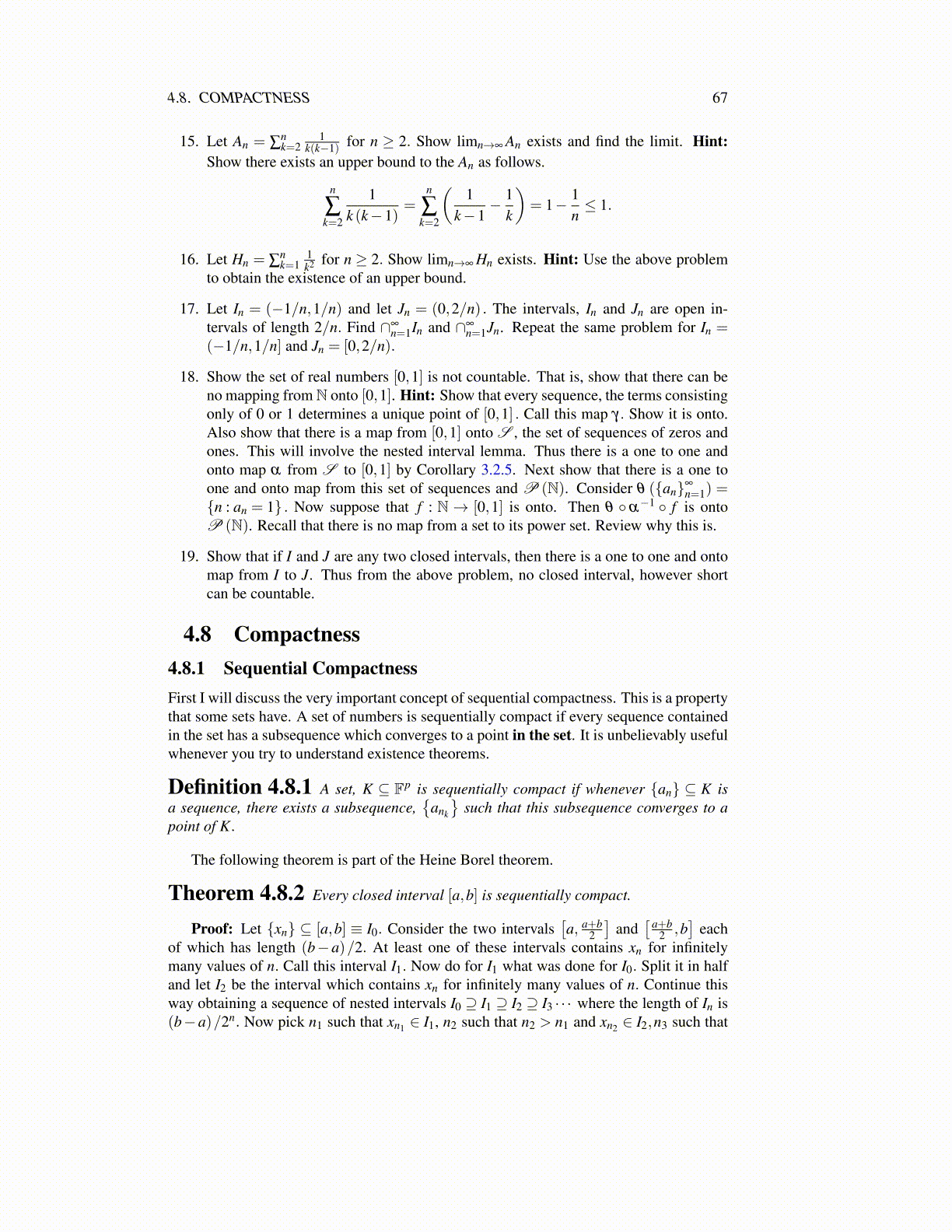
4.8. COMPACTNESS 67
Proof: It is necessary to show every point of B(p,δ ) is an interior point. Let x ∈B(p,δ ) . Then let r = δ −∥x− p∥. It follows r > 0 because it is given that ∥x− p∥ < δ .Now consider z ∈ B(x,r) . From Proposition 4.4.2, the triangle inequality,
∥z− p∥ ≤ ∥z− x∥+∥x− p∥< r+∥x− p∥= δ −∥x− p∥+∥x− p∥= δ
and so z ∈ B(p,δ ) . That is B(x,r)⊆ B(p,δ ) . Since x was arbitrary, this has shown everypoint of the ball is an interior point. Thus the ball is an open set.
Consider the last assertion. If y /∈ D(p,r) , then ∥y− p∥ > r and you could considerB(y,∥y− p∥− r) . If z ∈ B(y,∥y− p∥− r) , then
∥z− p∥ = ∥z− y+ y− p∥ ≥ ∥y− p∥−∥z− y∥> ∥y− p∥− (∥y− p∥− r) = r
and so z /∈D(p,r) showing that the complement of D(p,r) is open, so this set is closed.
Definition 4.8.7 Let A be any nonempty set and let x be a point. Then x is said tobe a limit point of A if for every r > 0,B(x,r) contains a point of A which is not equal to x.
The following proposition is fairly obvious from the above definition and will be usedwhenever convenient. It is equivalent to the above definition and so it can take the place ofthe above definition if desired.
Proposition 4.8.8 A point x is a limit point of the nonempty set A ⊆ Fp if and only ifevery B(x,r) contains infinitely many points of A, none of which are equal to x. In otherwords, there exists a sequence of distinct points of A none equal to x which converges to x.
Proof: ⇐ is obvious. Consider ⇒ . Let x be a limit point. Let r1 = 1. Then B(x,r1)contains a1 ̸= x. If {a1, · · · ,an} have been chosen none equal to x and with no repeats inthe list, let 0 < rn < min
( 1n ,min{∥ai− x∥ , i = 1,2, · · ·n}
). Then let an+1 ∈ B(x,rn)\{x} .
Thus an+1 is not equal to any of the earlier ak and every B(x,r) contains B(x,rn) for all nlarge enough. Hence B(x,r) contains ak for k ≥ n where the ak are distinct, and also noneare equal to x.
Example 4.8.9 Consider A = N, the positive integers. Then none of the points of A is alimit point of A because if n ∈ A,B(n,1/10) contains no points of N which are not equal ton.
Example 4.8.10 Consider A = (a,b) , an open interval in R. If x ∈ (a,b) , let
r = min(|x−a| , |x−b|) .
Then B(x,r)⊆ A because if |y− x|< r, then
y−a = y− x+ x−a≥ x−a−|y− x|= |x−a|− |y− x|> |x−a|− r ≥ 0
showing y > a. A similar argument which you should provide shows y < b. Thus y ∈ (a,b)and x is an interior point. Since x was arbitrary, this shows every point of (a,b) is aninterior point and so (a,b) is open.